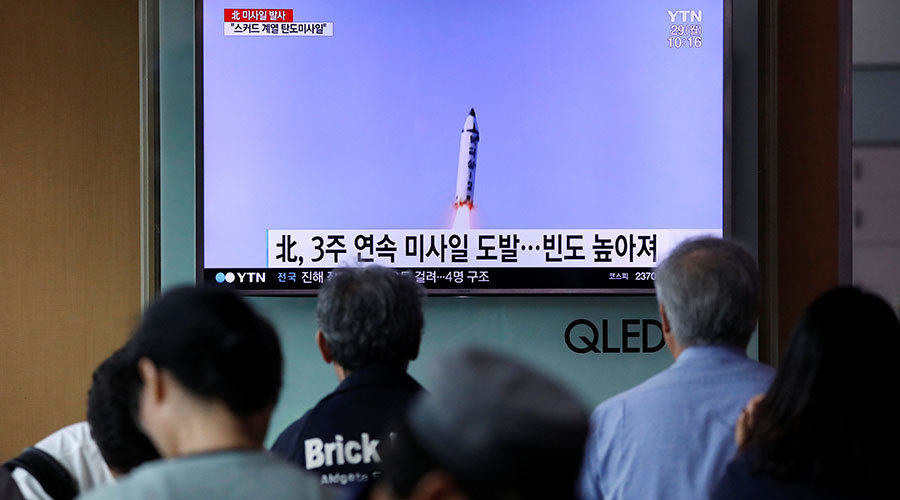
© Kim Hong-Ji / Reuters
Pyongyang has launched a missile which, according to the Japanese and South Korean governments, passed through northern Japan's airspace.
The Japanese government activated its J-Alert warning system after North Korea fired an unidentified missile early Tuesday morning.
The North Korean missile passed over Japanese territory around 6:06am local time, Reuters reports. The Japanese military did not attempt to shoot down the missile but warned people to take precautions.Meanwhile, South Korea's Joint Chiefs of Staff said Pyongyang fired a "projectile... in the direction of the East Sea (Sea of Japan) at 5:57am,"
according to Yonhap.
South Korea's military also
confirmed that the "ballistic missile" launched by Pyongyang flew over Japan.
"It passed through the sky over Japan," the JCS said. It added that the American and S. Korean militaries are now analyzing the latest North Korean missile launch.
The latest incident comes just three days after the North fired three short-range missiles into the Sea of Japan. According to the Pentagon, two of the missiles fell into the water, while a third blew up on the launch pad on August 26.
Following Tuesday's launch and flyby over Japanese territory, the country's prime minister vowed to do everything in his power to protect his nation.
"We will make utmost efforts to firmly protect the lives of the people," Shinzo Abe said Tuesday before convening an emergency session on the missile firing, Reuters reports.
The latest North Korean missile launches coincide with the annual US-South Korean Ulchi Freedom Guardian exercises which are set to wrap up on August 31.
The Pentagon previously stated that Pyongyang's behavior is nothing short of a provocation amid the heightened tensions on the peninsula, after two missiles flew some 250 kilometers before falling into the Sea of Japan Saturday.
"You're still firing missiles, so that's a threat. We look at that as a threat," Pentagon spokesman Col. Robert Manning told reporters,
according to Yonhap.
"If you're asking if those three short-range missiles was less of a threat, the answer is no. It was a provocative action," Manning added.
Stating that Saturday's test did not exhibit advancements in Pyongyang's ballistic missile technology, Manning however added that "we have to make the assumption that they continue to learn throughout each one of these missile launches."
"We watch (North Korea) very closely and we'd be postured to respond," the Pentagon spokesman concluded.
Tensions between Pyongyang and Washington reached new heights after US president Donald Trump recently threatened to unleash
"fire and fury" on North Korea if it continues making threats against the United States.
Trump's strong comments followed the July 28 Hwasong-14 ballistic missile launch by North Korea, after which Pyongyang boasted about having acquired the capability to strike the US mainland.
Pyongyang responded to Washington's rhetoric by saying it was working on a plan to launch a medium-range ballistic missile close to the US territory of Guam, some 3,200km from North Korea. Guam, a tiny US territory located in Micronesia in the western Pacific, is home to two major American military bases housing over 6,000 personnel.
In a related development, South Korea's National Intelligence Service warned Monday that its neighbor might be preparing its sixth nuclear weapon test from a nuclear test site in Punggye-ri. North Korea had conducted five nuclear tests - in 2006, 2009, 2013 and in January and September 2016. During the last test, the North claimed it had successfully detonated a small nuclear warhead.
Amid the ongoing North Korean ballistic tests, the UN Security Council earlier this month unanimously agreed on a new set of restrictive measures against Pyongyang. The new round of sanctions ban North Korean exports of coal, iron, iron ore, lead, lead ore and seafood. It also prohibits increasing the current numbers of North Korean laborers working abroad, new joint ventures with Pyongyang and new investments in joint ventures.
Reader Comments
to our Newsletter